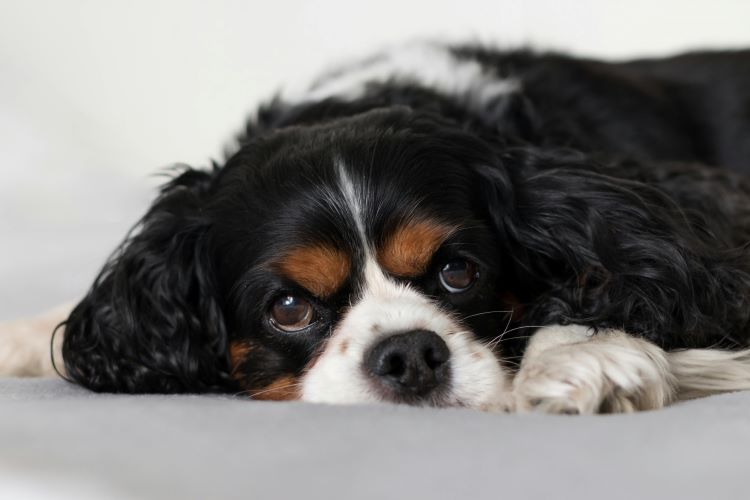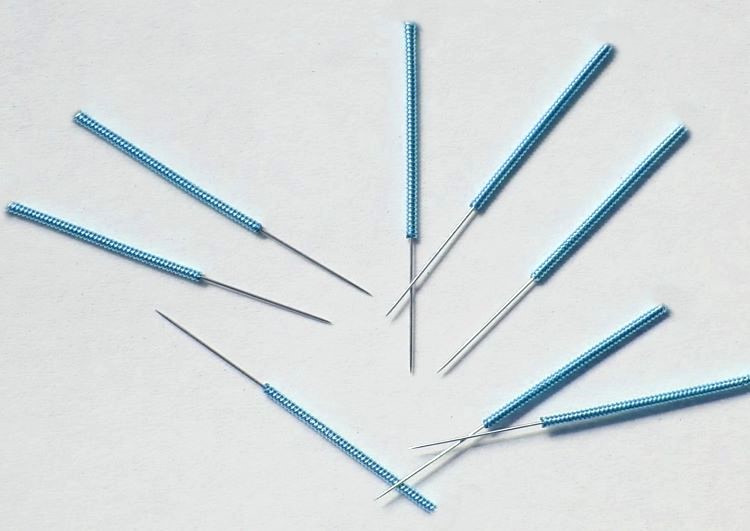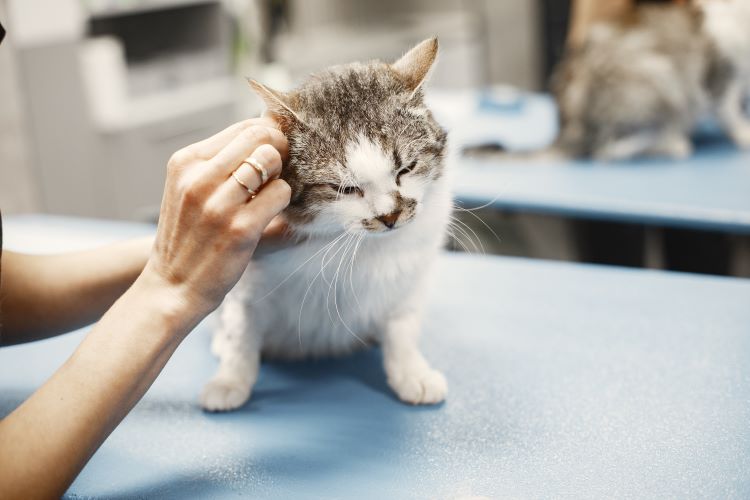Ready to help treat your pet to a healthy life?
What is Acupuncture for Pets? Effectiveness & Safety Precautions
By : Trupanion Staff | Updated May 7, 2024

It may seem strange to think of our pets undergoing a treatment such as acupuncture, particularly if you’re the owner of a mischievous canine or feline that struggles to sit still for long. And the fact that it involves needles? Yeah, right! But just like in humans, this alternative therapy has grown in prevalence in recent years among practitioners of veterinary medicine. It is now used to treat a surprising number of different conditions in animals, from osteoarthritis to incontinence.
But what is pet acupuncture exactly, and is it even effective? Most importantly, is it safe for your dog or cat? Before jumping too quickly into any new treatment for your furry friend, it’s vital to learn the basics about how veterinary acupuncture works as well as the reasoning behind it. While this article is here to help, always consult with an experienced and licensed veterinarian. Like other alternative treatments, acupuncture should be used in conjunction with conventional veterinary medicine instead of as a substitute.
What is veterinary acupuncture?
Acupuncture has been part of traditional Chinese medicine (also known as “TCM”) for thousands of years and has grown in recognition and use in recent decades among mainstream medicine practitioners around the world. There is evidence of the Shang and Chow dynasties practicing acupuncture on army horses in China as far back as 2000 BC. By the 17th century, the study of veterinary acupuncture had reached Europe, and the practice entered the broader US veterinary world in the 1970s.
The main idea behind acupuncture is that, by targeting key pressure points along the body with fine, shallow needles, energy imbalances can be corrected to promote natural self-healing and pain relief. Along with other types of alternative treatment, acupuncture has grown in recognition and is now used extensively in veterinary medicine.
In a veterinary setting, acupuncture is most commonly used in the rehabilitation of pets following orthopedic or spinal injuries, or in the treatment of chronic pain or musculoskeletal disorders. That said, it is also used to treat a wide variety of other illnesses and conditions, including respiratory, digestive, and reproductive problems. Pet acupuncture is used most often for treating dogs, but in recent years it has become a more prevalent option for cats as well.
Do cats and dogs have pressure points?
In the world of acupuncture, targeted pressure points are known as “meridians” and are traditionally considered channels of energy that connect different organs and tissues in the body. Cats and dogs are considered to have similar pressure points to humans, which is why the principles of acupuncture and acupressure can be applied to them as well.
From a scientific perspective, these meridians are located along the circulatory system near bundles of nerves and blood vessels, each of which link to different organs and muscle regions. Humans, dogs, and cats are all said to have 12 meridians, though their exact locations have been disputed by different practitioners and some scientific studies.
Conditions treated
Veterinary acupuncture is used to treat a wide range of conditions, including:
- Musculoskeletal problems, such as arthritis, intervertebral disk disease, or traumatic nerve injury
- Respiratory problems, such as feline asthma
- Skin problems such as lick granulomas and allergic dermatitis
- Gastrointestinal problems, such as diarrhea
- Selected reproductive problems
- Chronic pain conditions
- Slow-healing wounds and scar tissue pain
- Incontinence
- Behavioral problems
Benefits
More research is needed into the benefits of animal acupuncture, but it is offered by an increasing amount of veterinary practices. The primary benefit of acupuncture is believed to be the holistic nature of the treatment and its ability to encourage your pet’s body to heal itself. Proponents of the treatment believe it to stimulate the release of your pet’s own pain-relieving and anti-inflammatory hormones, thereby improving blood circulation, oxygenation, and the removal of metabolic wastes and toxins. Acupuncture is also minimally invasive, and very few pets require sedation during treatment.

Does pet acupuncture actually work?
Before pursuing acupuncture for your dog or cat, it’s a good idea to know what the science says. Among many veterinary practitioners, acupuncture is considered an effective drug-free alternative or accompaniment to conventional medicine.
While acupuncture has so far not been shown to be a cure for any condition in humans or animals, some clinical research has demonstrated positive results when performed correctly. In one Harvard Medical School study involving mice, researchers successfully identified a set of neurons that could be triggered by acupuncture to induce an anti-inflammatory response. However, these neurons were only found in the animals’ hind limbs, indicating acupuncture may not be as effective, if at all, in other areas of the body.
Still, other evidence exists for acupuncture’s efficacy. According to Today’s Veterinary Practice, multiple studies with dogs suffering from neurologic and musculoskeletal conditions saw a reduction in chronic pain after acupuncture treatment. Two additional studies likewise showed a reduced need for pain medication in cats receiving acupuncture after undergoing ovariohysterectomy (spaying).
The difference between acupuncture and acupressure
If you’re looking into acupuncture for your pet, you may have come across the term “acupressure” as well. This is another form of treatment — and another traditional Chinese medicine technique — that effectively follows the same basic concept as acupuncture. However, there is one important difference: acupressure does not involve needles. Instead, pet acupressure involves the practitioner applying careful pressure (usually with their hands) to the same key points along the body that are targeted during acupuncture sessions.
Because of the lack of needles, acupressure may be a more suitable choice for pets who are highly nervous around needles or move around a lot during veterinary exams. Acupressure may also be used as an introduction to help get pets used to similar sensations during acupuncture.
Additional similar treatments include the following:
- Acupuncture point injection: a treatment that involves the injection of various substances, such as homeopathic remedies, into the skin at acupuncture points.
- Moxibustion: a therapy that is often used to treat joint stiffness and muscular soreness by applying heat to acupuncture points to stimulate blood flow and relieve pain.
- Electrostimulation: the application of an electric current to acupuncture points. This type of therapy relaxes spasming muscles and can help repair nerve damage.
- Laser: a treatment that uses laser energy instead of needles to stimulate acupuncture points. This is a great alternative for pets who have an aversion to needles.
What to expect with acupuncture for pets
In the veterinary context, the practice of acupuncture is the same for dogs and cats as it is for humans, with some obvious caveats (which we’ll get into shortly). The practice involves inserting thin needles into these specific points on the body and letting them sit there for a short period of time (typically between a few seconds to 30 minutes). Dogs and cats are typically made to lie down on a comfortable surface while the veterinarian applies the needles, and many pets have even been reported to fall asleep during treatment.
While the exact amount of time will be predetermined by the veterinarian and may vary between pets, the end goal is always to help alleviate pain and speed up recovery. Your pet may be a bit sleepy after the process, but they should leave the appointment relaxed and, hopefully, with less pain.
Does acupuncture hurt animals?
Done correctly, acupuncture should not cause any pain to your pet or at most, an extremely light pinch. The needles are very fine compared to needles used for injections or sewing, and they are not inserted deep enough to draw blood or hit nerves. Because they are kept in only the surface layers of the skin, acupuncture is sometimes referred to as “dry needling.”
That said, some pets may still experience some discomfort during acupuncture sessions. This may especially be the case if they move suddenly during treatment and the needle ends up not being inserted correctly — all the more reason to consult with your veterinarian ahead of time and make informed decisions when it comes to your pet’s healthcare.
Precautions
As with any health treatment, precautions should be taken with acupuncture. To start, it should only be performed by a licensed veterinarian or licensed veterinary specialist referred by your veterinarian. It should go without saying, but acupuncturists who typically work only with humans should never work on your pet.
Your pet’s progress should also be monitored regularly by a veterinary professional, as the pain-relieving effects of acupuncture may mask symptoms and can delay healing if your pet becomes too active during rehabilitation. The good news is that acupuncture is considered a highly safe veterinary treatment when practiced correctly.

How much does pet acupuncture cost?
The cost of acupuncture for pets can vary depending on various factors such as the location, the experience of the practitioner, the specific needs of the pet, and the number of sessions required. In North America, veterinary acupuncture can cost anywhere from $25 to $300 per appointment.
As for specific pricing for your dog or cat, it's best to inquire directly with veterinary clinics or acupuncture practitioners in your area to get an accurate estimate for your pet's needs. Some practices may offer package deals for multiple sessions, which can help reduce the overall cost per session.
Pet insurance that covers acupuncture for dogs and cats
The good news is that some pet insurance plans cover acupuncture treatments, so it's always worth checking if your insurance policy includes coverage for alternative therapies. If you aren’t already signed up for pet health insurance, there’s no time like the present to find a provider that has this kind of comprehensive coverage.
Finding pet insurance that covers acupuncture treatment for dogs and cats can be a bit challenging depending on your situation. After all, pet insurance coverage varies greatly between providers as well as by location (typically due to differing local insurance regulations). Some insurers even have restrictions by breed. Fortunately, Trupanion has acupuncture coverage and does not impose restrictions on it by breed.
Trupanion’s pet acupuncture coverage (for treatments administered by a licensed veterinarian) is already included in many plans, and if it isn’t already included, there’s the option to add it on as part of a Recovery and Complementary Care Rider. This is to make sure every pet protected by Trupanion has access to all of the veterinary treatments that can help them live a comfortable, healthy life.
